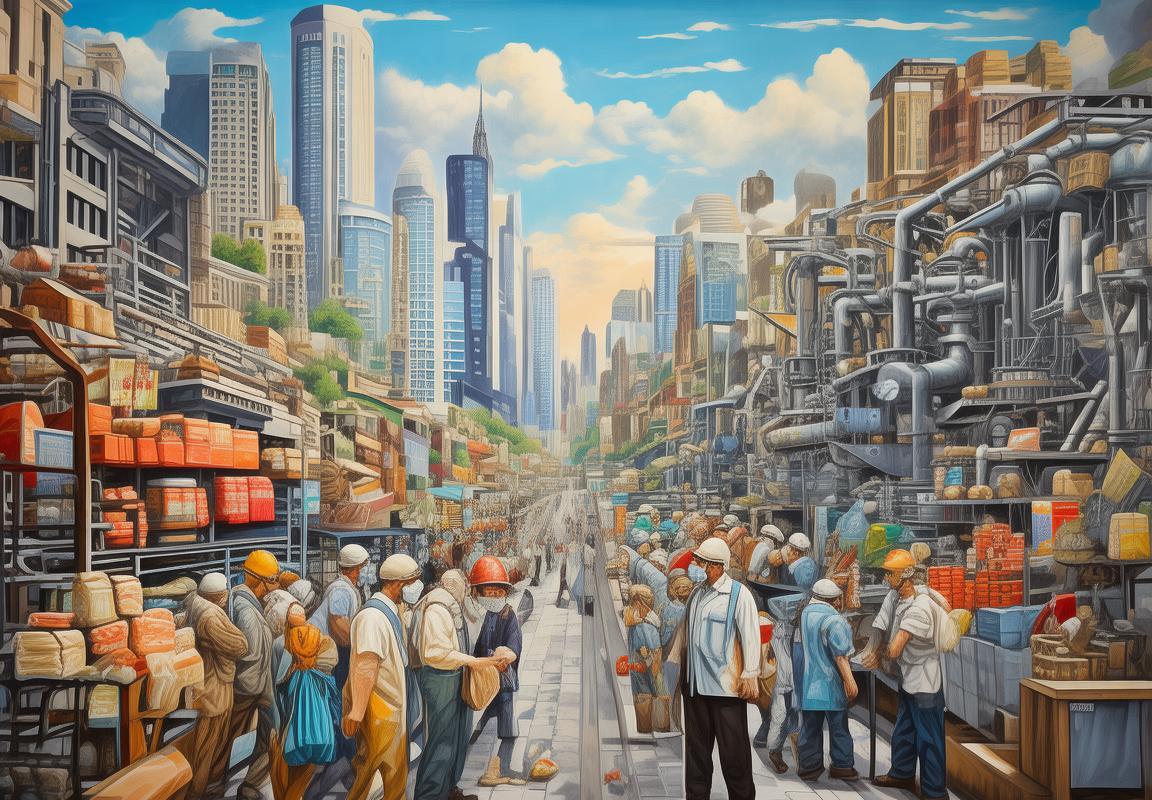In the ever-evolving landscape of international trade, the concept of import substitution has emerged as a pivotal strategy for many nations seeking to bolster their economies and reduce reliance on foreign goods. This approach, rooted in the desire for self-sufficiency and economic independence, involves developing domestic industries to replace imports. While the theory behind import substitution programs is straightforward, the complexities of implementing such policies can lead to a range of outcomes, both positive and negative. Let’s delve into the intricacies of these programs and explore how they have shaped and continue to shape the economic identities of various countries.
Understanding the Concept of Import Substitution Program
Import substitution programs, often abbreviated as ISPs, are a strategic economic approach aimed at reducing dependence on foreign goods by promoting the production of domestically manufactured products. At its core, the concept revolves around the idea of fostering a self-sustaining economy that can meet the needs of its citizens through local industry and agriculture.
These programs are typically implemented in developing countries where the importation of goods is high and the local industries are underdeveloped or struggling to compete with international markets. The goal is to protect and nurture these nascent industries by imposing tariffs, quotas, or other trade barriers on imported goods, thereby making locally produced items more attractive to consumers.
The origins of import substitution can be traced back to the late 1940s and early 1950s, when many newly independent countries in Latin America and Asia began to adopt this strategy as a means to break free from the economic domination of colonial powers. The rationale behind such a move was multi-faceted.
Firstly, import substitution aimed to reduce the trade imbalance and reserves that countries were often facing. By producing goods locally, nations could spend less on foreign currencies, which were needed to purchase imported goods. This helped to stabilize their economies and reduce the vulnerability to fluctuations in the global market.
Secondly, the strategy was seen as a way to promote national pride and sovereignty. By developing domestic industries, countries could reduce their reliance on foreign entities and demonstrate their ability to stand on their own two feet. It was a symbol of independence and self-reliance.
The mechanics of an import substitution program involve several key steps. Governments typically identify industries that are crucial for the country’s economic development and then create policies to support their growth. This can include the establishment of incentives for local businesses, such as tax breaks, subsidies, or grants. Additionally, regulations might be put in place to restrict the importation of foreign goods, making domestic products more competitive in the market.
The success of an import substitution program often hinges on the government’s ability to effectively manage the transition. This includes ensuring that the domestic industries are able to scale up production to meet the demand, maintaining quality standards, and preventing corruption that could hinder the program’s effectiveness.
Several countries have experienced varying degrees of success with import substitution programs. For instance, Brazil and Mexico are often cited as examples of countries that managed to industrialize and reduce their dependence on imports. In Brazil, the policy was known as the “Import Substitution Industrialization” (ISI) and played a significant role in the country’s economic growth during the mid-20th century.
However, the challenges of import substitution are numerous. One of the primary issues is the potential for inefficiency and lack of competitiveness. When industries are shielded from foreign competition, they may not be motivated to innovate or improve their processes, leading to higher costs and lower quality. This can result in a lack of consumer choice and, ultimately, economic stagnation.
Moreover, import substitution programs can lead to protectionist sentiments and a closed economy, which can limit the country’s access to foreign capital and technology. Over time, this can create a barrier to international trade and investment, which are essential for economic diversification and growth.
In recent years, the role of technology and innovation has become increasingly important in the context of import substitution. As global markets become more interconnected, countries are looking for ways to leverage technology to enhance their domestic industries. This includes investing in research and development, adopting new production methods, and fostering a culture of entrepreneurship.
Looking ahead, the future of import substitution programs is likely to be shaped by the globalizing world. While the concept remains relevant for countries seeking to develop their economies, the emphasis may shift from protectionism to strategic trade policies that promote balanced and sustainable economic growth. This could involve a combination of import substitution, export promotion, and regional trade agreements that benefit all parties involved.
In conclusion, import substitution programs are a complex economic strategy that requires careful planning and execution. While they have the potential to foster national industries and reduce dependence on foreign goods, they also come with challenges that must be addressed. As the global economic landscape continues to evolve, the role of import substitution programs will undoubtedly adapt to new realities, seeking a balance between self-reliance and international integration.

The Background and Rationale for Import Substitution
The roots of import substitution programs can be traced back to a time when many developing nations sought to reduce their dependence on foreign countries for essential goods. Economic nationalism was a driving force behind this movement, as governments aimed to foster domestic industries and protect their economies from the fluctuations of global markets.
Historically, the late 1940s and early 1950s saw a surge in the adoption of import substitution policies. These programs were often spurred by the aftermath of World War II, which had disrupted global trade and supply chains, leaving many countries with a need to rebuild their industries. The idea was to create self-sufficient economies by producing goods domestically instead of importing them.
Economic reasons played a significant role in the rationale behind import substitution. Developing countries often faced high trade deficits, as they imported more than they exported. This not only put a strain on their foreign exchange reserves but also resulted in a loss of jobs and economic growth opportunities. By substituting imports with domestically produced goods, these nations hoped to stimulate their own economies and reduce their reliance on foreign markets.
Moreover, political motivations fueled the push for import substitution. Governments were concerned about the political power that foreign corporations held within their borders. By promoting domestic industries, leaders aimed to strengthen national sovereignty and reduce the influence of multinational companies.
Another key rationale for import substitution was the desire to develop local capabilities and technology transfer. Many developing nations believed that by producing goods domestically, they could attract foreign investment and expertise, which would ultimately lead to technological advancements and an increase in the country’s overall competitiveness.
The concept of import substitution was also influenced by the theories of economic development. Economists like Raul Prebisch and Hans Singer, known for their “dependency theory,” argued that the global economic system was inherently unequal, with developed countries exploiting the resources and labor of developing nations. Import substitution was seen as a way to break free from this cycle of dependency and create a more balanced global economic order.
In practice, import substitution programs typically involved the imposition of tariffs and trade barriers to protect domestic industries from foreign competition. Governments often provided subsidies and incentives to encourage the establishment and growth of domestic production. This protective stance was intended to give new industries the time and resources needed to become competitive.
However, the success of import substitution was not guaranteed. These programs often faced criticism for their potential to lead to inefficiencies and distortions in the market. The artificially high prices and lack of competition could stifle innovation and discourage efficiency, as domestic industries had little motivation to improve their production processes.
Additionally, import substitution programs could create a “resource curse,” where a country’s focus on one particular industry led to neglect of other sectors, potentially causing imbalances in the economy. There was also the risk of creating monopolies and limiting consumer choice, as protected industries had less incentive to innovate and cater to consumer needs.
Despite these challenges, the appeal of import substitution remained strong for many developing countries. The promise of economic independence and self-reliance was difficult to resist, especially in the context of the Cold War, where political alliances often influenced economic policies.
In summary, the background and rationale for import substitution programs were multifaceted, encompassing economic, political, and developmental goals. The desire to reduce dependence on foreign goods, protect national interests, and foster economic growth were central to the rationale behind these policies. However, the effectiveness and sustainability of import substitution programs have been a subject of debate, with some arguing that they can lead to unintended consequences and long-term economic challenges.

How Import Substitution Programs Work in Practice
Import substitution programs are a strategic approach used by governments to reduce dependence on foreign goods and services by promoting domestic production. These programs often work through a combination of policies and initiatives aimed at fostering a competitive domestic industry capable of meeting the nation’s needs. Here’s a glimpse into how these programs function in practice:
Government Support and IncentivesGovernments implementing import substitution programs typically offer a range of support mechanisms to domestic producers. This can include subsidies for raw materials, tax breaks, and low-interest loans. By providing these incentives, governments aim to make domestic production more cost-competitive compared to imported goods.
Trade RestrictionsTo protect domestic industries, import substitution programs often involve the implementation of trade barriers. These can take the form of tariffs, quotas, or non-tariff barriers such as technical standards and regulations that make it difficult for foreign companies to enter the market.
Development of Domestic IndustryCentral to import substitution is the development of domestic industries. This may involve investing in research and development, improving infrastructure, and providing training and education for workers. Governments might also establish special economic zones or industrial parks to attract and support local businesses.
Strategic Planning and Priority SettingImport substitution programs require careful planning and prioritization. Governments must identify which sectors to focus on, based on the country’s comparative advantages and the most pressing national needs. For instance, a country might prioritize the development of agricultural products, manufacturing, or technology.
Public-Private PartnershipsIn some cases, import substitution programs rely on partnerships between the government and private sector. These collaborations can help bridge the gap between government objectives and the realities of market dynamics. Private companies may provide expertise, capital, and market access in exchange for government support.
Technology Transfer and InnovationTo succeed, import substitution programs often require the transfer of technology from abroad. This can be achieved through foreign direct investment, joint ventures, or licensing agreements. Additionally, fostering innovation within domestic industries is crucial for the long-term success of the program.
Consumer AdjustmentAs domestic products replace imports, consumers may face a shift in quality, variety, and price. Import substitution programs must consider how consumers will adapt to these changes. In some cases, this may involve educating consumers about the benefits of domestic products or offering incentives to switch to locally produced goods.
International Trade RelationsImport substitution programs can strain international trade relations. Countries that impose trade barriers may find themselves on the receiving end of retaliatory measures from trading partners. This dynamic requires careful navigation and diplomacy to avoid negative impacts on the global economy.
Monitoring and EvaluationEffective implementation of import substitution programs requires continuous monitoring and evaluation. Governments must assess the impact of their policies on domestic industries, employment, and overall economic growth. Adjustments may be needed to address any unintended consequences or to capitalize on emerging opportunities.
Long-Term SustainabilityThe success of import substitution programs is not just about short-term gains but also about long-term sustainability. This means ensuring that domestic industries can continue to innovate, compete globally, and adapt to changing market conditions. Governments must create an environment where industries can thrive and evolve over time.
ConclusionImport substitution programs in practice are complex and multifaceted. They involve a blend of economic, political, and social strategies that aim to foster self-sufficiency and economic independence. While these programs can yield significant benefits, they also come with challenges that require careful management and flexibility to navigate successfully.

Success Stories: Countries That Benefited from Import Substitution
In the realm of economic development, import substitution programs have been a strategy employed by numerous countries to reduce dependence on foreign goods and foster domestic industries. This approach has led to several success stories where nations have managed to thrive and strengthen their economies through self-sufficiency. Here are some notable examples:
Brazil’s Rise in Steel ProductionBrazil’s import substitution program in the 1960s and 1970s aimed to reduce its reliance on imported steel. The government provided subsidies, tax incentives, and protected domestic steel manufacturers. This support led to the growth of companies like CSN and Usiminas, which became significant players in the global steel market. As a result, Brazil’s steel industry expanded, and the country became a major exporter, reducing its import bill and bolstering its economy.
Mexico’s Pharmaceutical Industry GrowthMexico’s import substitution program focused on the pharmaceutical sector, aiming to produce essential medicines domestically. The government offered incentives to local pharmaceutical companies, including tax breaks and grants. This strategy led to the development of a robust pharmaceutical industry, with companies like Laboratorios Liomont and Laboratorios Chilango emerging as key players. The success of this program not only reduced the country’s reliance on imported drugs but also made Mexico a regional pharmaceutical hub.
India’s Textile Industry BoomIndia’s import substitution program, particularly in the textile sector, aimed to promote domestic manufacturing and reduce imports. The government implemented high tariffs on imported textiles and provided subsidies to local manufacturers. This support spurred the growth of the textile industry, with brands like Arvind Limited and Raymond becoming household names. The domestic textile industry expanded significantly, creating jobs and contributing to India’s economic growth.
South Korea’s Electronics RevolutionSouth Korea’s import substitution program in the 1960s focused on developing its electronics industry, which was heavily reliant on imports. The government provided substantial support to domestic electronics companies, including financial assistance and protectionist measures. This strategy led to the rise of giants like Samsung and LG, which became global leaders in the electronics sector. The success of this program transformed South Korea into a high-tech powerhouse, reducing its dependency on foreign electronics and propelling the nation’s economic growth.
Turkey’s Automotive Industry TakeoffTurkey’s import substitution program targeted the automotive sector, aiming to reduce imports and develop a domestic manufacturing base. The government offered incentives such as tax breaks and low-interest loans to local automakers. This support enabled companies like Otokar and Tofas to grow and compete with international brands. As a result, Turkey’s automotive industry flourished, becoming a significant player in the global market and reducing the country’s import dependence.
Argentina’s Food Processing SectorArgentina’s import substitution program focused on the food processing sector, aiming to produce basic food items domestically. The government provided subsidies and protected the local industry through tariffs. This strategy led to the growth of companies like Arcor and La Serenísima, which became dominant players in the domestic market. The success of this program not only reduced Argentina’s import bill but also supported the country’s agricultural sector.
These success stories demonstrate that import substitution programs can be effective in fostering domestic industries and reducing dependence on foreign goods. However, it’s important to note that these programs often require significant government intervention, long-term commitment, and strategic planning to achieve sustainable results.

Challenges and Critics of Import Substitution Programs
Import substitution programs, while aiming to foster self-sufficiency and national economic growth, have faced a myriad of challenges and criticisms. These issues often arise from the practical implementation of such policies, as well as their long-term sustainability and impact on the global economy.
One significant challenge is the inefficiency that can arise from attempting to produce goods domestically that are typically cheaper and more efficient when imported. This inefficiency can lead to higher costs for consumers and businesses, as well as reduced quality in the domestic products. The lack of competition from international markets can also stifle innovation and lead to a lack of motivation for domestic manufacturers to improve their processes.
Moreover, import substitution programs often face issues related to the development of domestic industries. These programs require a strong foundation in terms of infrastructure, skilled labor, and technology transfer. Without these, the growth of domestic industries can be slow and fraught with difficulties. For instance, when a country tries to produce goods that it previously imported, it may lack the necessary expertise or machinery to do so effectively, leading to subpar products and a damaged reputation for the domestic brand.
Another challenge is the potential for corruption and political interference. Import substitution programs can be susceptible to manipulation by political actors, who may prioritize certain industries or companies for their own gain rather than the overall economic welfare. This can lead to misallocation of resources and favoritism, which undermine the integrity of the program.
Critics argue that import substitution programs can also create trade barriers and distort global trade patterns. By limiting foreign competition, these programs can lead to higher prices for consumers and reduced quality of goods, as domestic producers may not be as incentivized to maintain high standards. Additionally, they can result in a lack of diversity in the market, as domestic industries may not be able to produce a wide range of goods that cater to different consumer needs.
Furthermore, the economic impact of import substitution programs is not always positive. While they may boost certain sectors of the economy, they can also create imbalances. For example, if a country focuses on producing basic goods like food or textiles, it may neglect the development of other industries that could drive innovation and economic growth. This can lead to a one-dimensional economy that is vulnerable to external shocks and changes in global trade.
One of the most notable criticisms is the potential for these programs to lead to a “resource curse.” By focusing on developing certain industries, a country might overexploit its natural resources or deplete them prematurely, without diversifying its economic base. This can result in a reliance on non-renewable resources that, once depleted, leave the country with a weakened economy.
Moreover, import substitution programs can sometimes lead to a lack of foreign exchange reserves. As a country spends more on domestic production, it may need to import less, which can reduce the inflow of foreign currency. This can be particularly problematic for countries that rely heavily on exports for their foreign exchange earnings.
Lastly, the global economic landscape has changed significantly since the heyday of import substitution programs. With the advent of globalization and the increasing interconnectedness of economies, the idea of protecting domestic industries through import substitution may seem outdated. International trade agreements and the ease of cross-border transactions have made it easier for countries to import goods at competitive prices, making the barriers to entry for import substitution more challenging than ever.
In summary, while import substitution programs were once seen as a path to economic independence and growth, they are not without their challenges and critics. The inefficiencies, political challenges, and global economic shifts have called into question the viability and wisdom of such policies, especially in the long term.

The Role of Technology and Innovation in Modern Import Substitution
In the realm of import substitution, technology and innovation play a pivotal role in shaping the success or failure of such programs. The integration of advanced technologies and creative solutions can significantly impact the ability of a country to produce goods domestically that were once solely imported. Here’s how technology and innovation are at the forefront of modern import substitution efforts:
The Digital Transformation of ManufacturingDigital technologies, such as the Internet of Things (IoT), robotics, and automation, have revolutionized the manufacturing sector. These advancements allow for greater efficiency, precision, and scalability, which are crucial for producing goods at competitive prices. By adopting digital tools, companies can reduce production costs, improve quality control, and meet the demands of the domestic market without relying on foreign suppliers.
The Power of Research and DevelopmentInvesting in research and development (R&D) is a cornerstone of import substitution. Countries that prioritize R&D are better equipped to innovate and create new products that can replace imports. This not only fosters economic growth but also enhances national capabilities and independence. R&D initiatives often lead to breakthroughs in materials science, biotechnology, and other fields, which can drive the development of substitute products.
Collaboration with Academic InstitutionsModern import substitution programs often involve collaboration between industry and academic institutions. Universities and research centers can provide the theoretical foundation and technical expertise needed to develop new products and processes. This partnership helps bridge the gap between academic research and practical application, ensuring that technological advancements are translated into tangible benefits for the domestic market.
Green Innovation for SustainabilityAs the world becomes more environmentally conscious, green innovation has become a key component of import substitution. Countries are increasingly looking to produce goods that are not only cost-effective but also sustainable. This includes developing renewable energy technologies, eco-friendly materials, and products that reduce waste. By focusing on green innovation, countries can address both economic and environmental challenges through import substitution.
The Role of Intellectual PropertyIntellectual property (IP) protection is vital in the context of import substitution. When companies invest in developing new technologies and products, they need to have confidence that their innovations will be protected from piracy and imitation. Strong IP laws encourage domestic companies to innovate, knowing that they can reap the rewards of their efforts. This protection is especially important in industries where the cost of research and development is high.
Overcoming Skill GapsOne of the challenges in import substitution is the skill gap within the workforce. To successfully implement these programs, countries must invest in education and training to ensure that their workers have the necessary skills to operate modern manufacturing facilities. Technology and innovation can help bridge these gaps by providing tools and resources that facilitate skill development and upskilling.
Global Trends and Technological LeapsGlobal trends, such as the rise of Industry 4.0, are pushing countries to embrace technology and innovation in their import substitution strategies. Keeping up with technological leaps means staying abreast of international advancements and adapting them to the domestic context. This can involve everything from adopting new software and machinery to rethinking supply chain management and distribution networks.
The Importance of Strategic PartnershipsStrategic partnerships between domestic companies and international technology providers can accelerate the adoption of new technologies. These collaborations can help countries leapfrog to the latest technologies without having to reinvent the wheel. By leveraging the expertise of international partners, countries can enhance their import substitution capabilities and accelerate their journey towards self-sufficiency.
The Challenges of IntegrationWhile technology and innovation offer promising avenues for import substitution, integrating these advancements into existing industries can be challenging. Legacy systems, outdated infrastructure, and resistance to change can hinder the adoption of new technologies. Overcoming these challenges requires a comprehensive approach that includes government support, industry incentives, and a commitment to long-term planning.
In conclusion, the role of technology and innovation in modern import substitution programs is undeniable. By harnessing the power of digital transformation, investing in R&D, and fostering collaboration, countries can move towards greater self-reliance. However, it’s a complex journey that requires careful planning, strategic partnerships, and a willingness to adapt to the rapidly evolving technological landscape.

The Future of Import Substitution Programs in a Globalizing World
In the ever-evolving landscape of global trade, import substitution programs have played a significant role in shaping the economic strategies of many nations. These initiatives aim to reduce dependence on foreign goods by developing domestic industries capable of producing essential products. As the world continues to globalize, the future of such programs is a topic of great interest. Here’s a closer look at the potential paths and challenges ahead.
The increasing interconnectedness of economies means that the traditional barriers to trade are often circumvented. Yet, despite this, import substitution programs remain relevant for several reasons. Countries may seek to enhance national security by ensuring critical goods are not solely dependent on foreign suppliers. Additionally, these programs can foster local innovation and development, potentially leading to more competitive domestic industries in the long run.
One key aspect of the future of import substitution programs lies in their ability to adapt to the dynamic nature of global markets. As consumer preferences shift and technological advancements occur, the focus of these programs must evolve. For instance, countries that once prioritized the production of basic goods like textiles and food may now need to concentrate on high-tech sectors, such as pharmaceuticals and renewable energy.
The role of technology in modern import substitution cannot be overstated. Advanced manufacturing techniques, automation, and digitalization can significantly enhance a country’s capacity to produce a wide array of goods. This shift towards technology-driven import substitution allows for the development of more sophisticated and complex products, which can be competitive on a global scale.
However, the integration of technology also brings challenges. High initial investment costs, the need for skilled labor, and the risk of becoming overly dependent on foreign technology can hinder the success of these programs. Countries must strike a balance between leveraging foreign technology and developing their own capabilities to ensure sustainable growth.
Another critical factor in the future of import substitution programs is the international political environment. Trade agreements, tariffs, and sanctions can all impact the feasibility and effectiveness of these initiatives. In a world where geopolitical tensions are on the rise, countries may find themselves navigating complex trade relationships that could either support or undermine their import substitution goals.
Moreover, the environmental impact of import substitution programs must be considered. As the global community increasingly focuses on sustainability, the production processes of domestic industries must be environmentally friendly. This means that import substitution efforts must incorporate green technologies and practices to mitigate negative ecological effects.
In terms of market access, the future of import substitution programs will likely involve a more nuanced approach. Countries may need to engage in strategic trade policies that blend protectionism with the opening of certain markets to foreign goods. This could be achieved through selective tariffs, trade agreements that benefit certain sectors, or the creation of regional economic blocs that support domestic industries.
Furthermore, the success of import substitution programs in the future will depend on the ability of governments to create a conducive business environment. This includes providing incentives for investment, ensuring legal stability, and fostering a culture of entrepreneurship. A supportive policy framework can attract both domestic and foreign capital, which is crucial for the growth and development of local industries.
Lastly, the future of import substitution programs must also address the issue of inequality. While these programs aim to boost economic growth, they must not leave behind segments of the population. Ensuring that the benefits of import substitution are distributed equitably is essential for long-term stability and success.
In conclusion, the future of import substitution programs in a globalizing world is multifaceted. It requires a careful balance between technological advancement, environmental sustainability, political astuteness, and social justice. As countries continue to navigate the complexities of global trade, the adaptability and foresight of their import substitution strategies will be pivotal in determining their economic trajectory.

Conclusion: Balancing Imports and Self-Reliance
In the intricate tapestry of international trade and economic development, the balance between importing goods and fostering self-reliance is a delicate dance. This conclusion explores the complexities of this balance, highlighting the evolving strategies of import substitution programs and the importance of a nuanced approach to achieving economic independence without sacrificing global connectivity.
As the world continues to globalize, the once straightforward idea of self-sufficiency through import substitution faces new challenges and opportunities. The quest for self-reliance must now be intertwined with the benefits of international trade, ensuring that national economies can thrive while maintaining a degree of independence.
The past successes of import substitution programs, such as those seen in Argentina and Brazil in the 1940s and 1950s, have shown that these strategies can stimulate domestic industries and reduce dependence on foreign goods. However, the current global landscape is vastly different, with a more interconnected global supply chain and the rise of emerging markets.
One key aspect of the future of import substitution programs lies in the integration of technology and innovation. As countries seek to develop their own industries, they must do so with an eye towards the latest advancements. This means investing in research and development, fostering a culture of innovation, and creating an environment where entrepreneurs can thrive. By embracing technology, countries can produce goods more efficiently and compete on a global scale.
Moreover, the future of import substitution programs will depend on the ability of governments to adapt and respond to the changing needs of their populations and industries. This requires a nuanced understanding of the domestic market, as well as the international market. It means recognizing which industries have the potential to be competitive on a global level and which ones need targeted support to grow.
The role of international partnerships and alliances cannot be understated. Countries that collaborate and share resources can often achieve more than they could on their own. This could mean joint ventures in technology, pooling research and development efforts, or even sharing intellectual property. In this way, the spirit of import substitution can be rejuvenated, but with a more global perspective.
However, despite these opportunities, there are significant challenges. One of the most pressing is the potential for inefficiency. Import substitution programs can lead to overproduction, as countries attempt to meet domestic demand without considering the global market. This can lead to wasted resources and a lack of competitiveness in the international arena.
Another challenge is the issue of quality. In the pursuit of self-reliance, there can be a tendency to prioritize quantity over quality, which can undermine the long-term viability of domestic industries. Ensuring that products meet international standards is crucial, as it can open up new markets and encourage foreign investment.
Furthermore, the global nature of the economy means that protectionist measures can have unintended consequences. Tariffs and trade barriers can lead to retaliatory actions from other countries, potentially isolating a nation and negatively impacting its economic growth.
Yet, even with these challenges, the future of import substitution programs is not without hope. By focusing on the development of human capital, investing in education and vocational training, countries can build a skilled workforce that can drive innovation and productivity. This, in turn, can help to create industries that are not only self-sustaining but also globally competitive.
In conclusion, the balance between importing and self-reliance is a complex one, and the future of import substitution programs must reflect this complexity. It requires a careful blend of strategic planning, technological innovation, and international collaboration. The goal is not to isolate nations but to empower them to thrive within the global economy while maintaining their unique economic identities. The path ahead is fraught with challenges, but with a forward-thinking approach, the future of import substitution programs can be both prosperous and sustainable.